Microscopy Devices Market Size
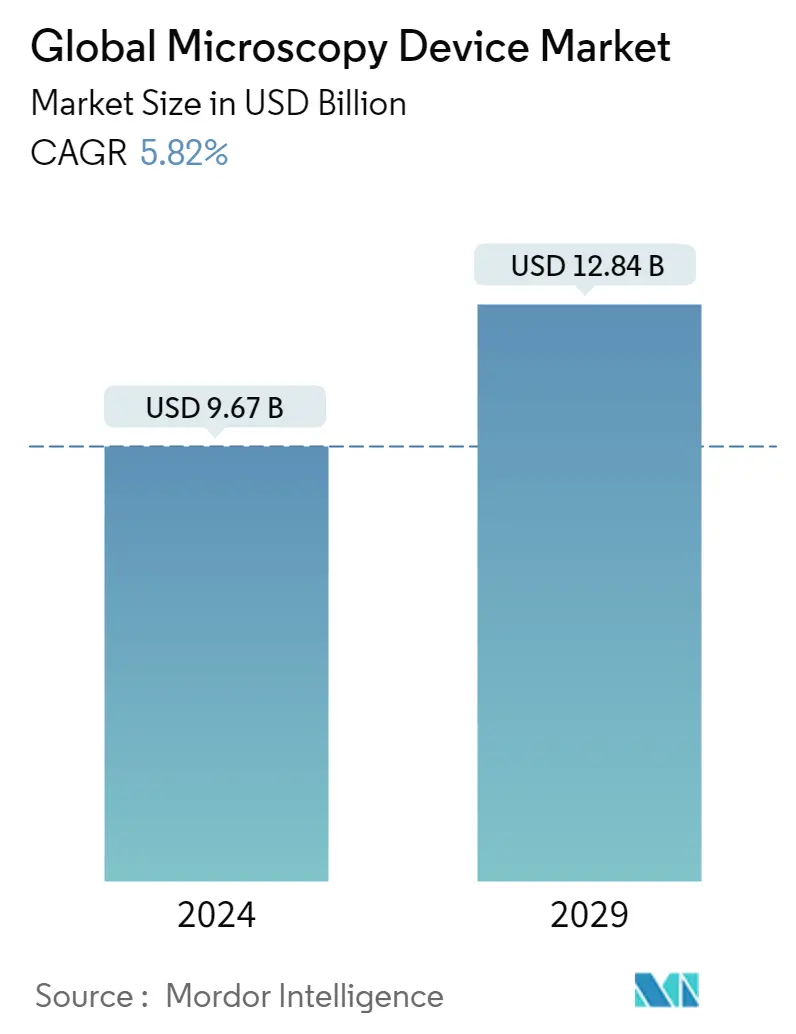
| Study Period | 2019 - 2029 |
| Market Size (2024) | USD 9.67 Billion |
| Market Size (2029) | USD 12.84 Billion |
| CAGR (2024 - 2029) | 5.82 % |
| Fastest Growing Market | Asia-Pacific |
| Largest Market | North America |
Major Players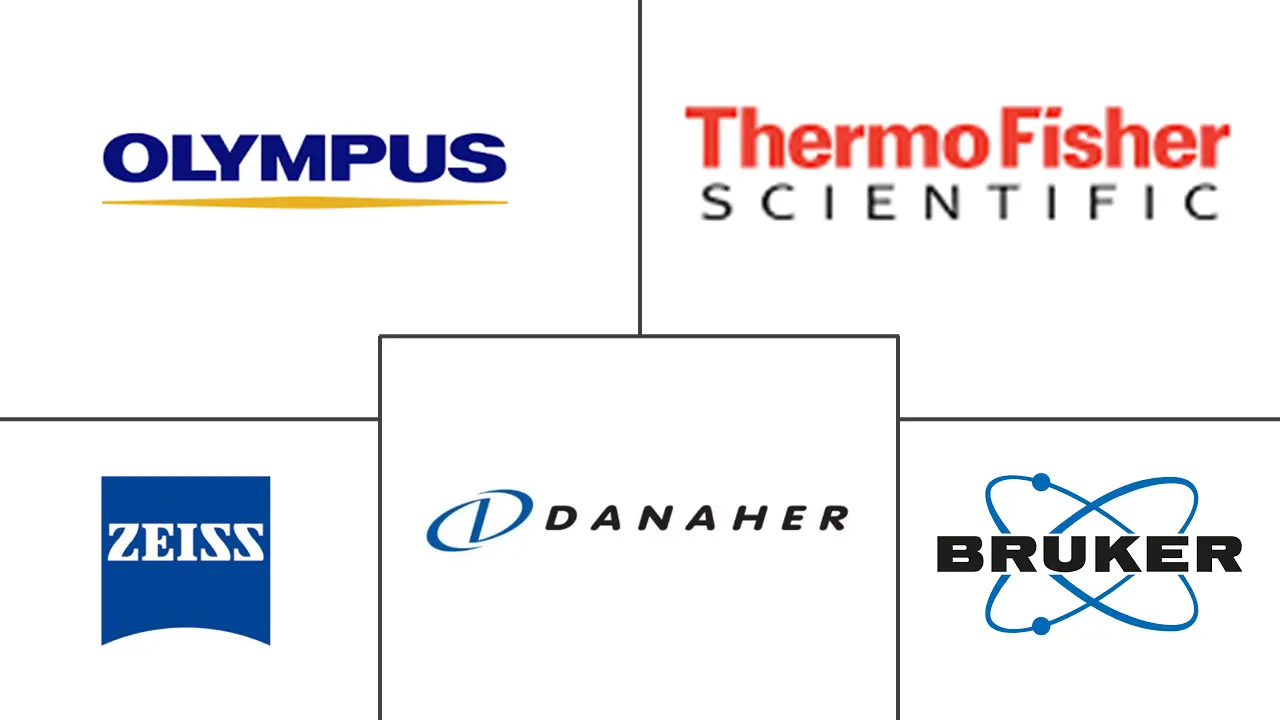
*Disclaimer: Major Players sorted in no particular order |
Need a report that reflects how COVID-19 has impacted this market and its growth?
Microscopy Devices Market Analysis
The Global Microscopy Device Market size is estimated at USD 9.67 billion in 2024, and is expected to reach USD 12.84 billion by 2029, growing at a CAGR of 5.82% during the forecast period (2024-2029).
The microscopy devices are mainly used in the research and development activities in different industrial areas such as pharmaceuticals, electronics, life sciences, and others, and as there was lockdown or lockdown like restrictions around the world due to the COVID-19 pandemic, these activities were negatively impacted, and thus impacting the microscopy devices market around the world shortly. Although, the electron and other microscopes were very crucial in the structural analysis of the SARS-COV-2 virus which was very important in the development of diagnostics tests and vaccines against COVID-19. For example, according to the research article published in September 2020 in the 'Nature' journal, the researchers used high-resolution scanning electron microscopy for the ultrastructural analysis of the SARS-CoV-2 virus' interaction with the host cell. Also, due to COVID-19, the manufacturing, sales, and installment of the new microscopy devices were negatively impacted but with the increasing vaccination and decreasing infection cases, the market is expected to recover soon from the impact of COVID-19.
The technological advancements in the field of microscopy and improvements in the available devices are one of the major driving growth factors for the studied market along with the increasing research and development activities and investments in the area of nanotechnology and life sciences, globally. For instance, in December 2021, researchers from École Polytechnique fédérale de Lausanne (EPFL), Max Planck Institute for Biophysical Chemistry, and the University of Göttingen, developed a transmission electron microscope (TEM) with an advanced technique that enables a strong modulation of the electron beam, with only a few milli-Watts from a continuous wave laser. The approach constitutes a more simplification and efficiency increase in the optical control of electron beams, which can be seamlessly implemented in a regular transmission electron microscope and could make the scheme much more widely applicable. In the life science segment, the use of microscopy devices in the identification and diagnosis of microorganisms and viruses causing disease in humans, animals, or plants are increasing which will complement the growth of the market.
Furthermore, rising investments in the field of microscopy will further support new innovations which will b a key driving factor during the study period. For instance, in November 2021, Surrey won GBP 0.6 million Core Equipment Award from the Engineering and Physical Sciences Research Council (EPSRC) to develop a transmission electron microscope that allows users to see materials in three dimensions and to employ a host of other imaging techniques and fast chemical analysis, enabling new insights into the mechanisms and processes that happen within materials.
A wide variety of technologies associated with microscopes has opened up multiple lines of investigations. Electron cryo-microscopy has the ability toreveal the atomic structure of biomolecules such as proteins In addition Fluorescence microscopy has helped biologists to observe live samples in real-time. Moreover, an increasing number of inventions has also led to several advances such as the visualization of a broad range of morphologic features.
Also, the companies which offers microscopy devices are actively involved in the research and development of new innovative solutions for the studied market to have an edge over other competitors which will boost the growth of the microscopy devices market during the forecast period. For instance, in November 2021, JEOL Ltd. launhced a new scanning electron microscope (SEM), the JSM-IT510 series which allows the user to simply select the acquisition conditions and field of view for the SEM image, and then the SEM image is automatically acquired, thus making routine work more efficient. The Low-vacuum Hybrid Secondary Electron Detector (LHSED) in this microscope collects both electron and photon signals providing an image with high S/N and enhanced topographic information even under a low vacuum.
Other factors which will be the contributing factor for the growth of the microscopy device market are its demand in the electronics industry in the development of the semiconductor chips, in the material science and others. However, high cost associated with the advanced microscopy devices will impede the growth of the microscopy device market during the forecast period.
Microscopy Devices Market Trends
This section covers the major market trends shaping the Microscopy Device Market according to our research experts:
Electron Microscopy is Expected to Witness a Rapid Growth in the Microscopy Device Market During Forecast Period
Electron microscopy is a technique for obtaining high-resolution images at the speed of biological as well as non-biological samples. It is one of the most important techniques available for the analysis of properties such as morphology, crystal and defect structure, elemental composition, and electronics of any kind sample. The electron microscopy devices are preferred over other types of devices due to factors like availability of higher magnification and resolution, diverse areas of application and it produces very high-quality images which is one of the major factors for the growth of the market.
The electron microscopy segment is dominated by companies, such as ThermofisherScientific), Hitachi, Carl Zeiss, and JEOL Ltd. Electron microscopy has high magnification ratio and have vital applications in material science, biology, nanotechnology and semiconductors sectors.
The growing product launches throughout the globe are increasing the usage of these devices forecasting good growth in the coming years. For instance, in November 2021, JEOL Ltd., launched a new scanning electron microscope (SEM), the JSM-IT510 series, JSM-IT510 Series InTouchScope, which is said to be easy to acquire data for all specimen types.
In July 2021, Thermo Fisher Scientific has announced the Thermo Scientific Phenom Pharos G2 Desktop Field Emission Gun - Scanning Electron Microscope (FEG-SEM) designed to increase access to advanced nanomaterial research capabilities. In Aug 2020, JEOL Ltd released a new scanning electron microscope (SEM), the JSM-IT700HR InTouchScope SEM for unprecedentedly high throughput.
In May 2020, JEOL Ltd unveiled JSM-IT800, a new Schottky field-emission scanning electron microscope (SEM) with features of in-lens Schottky Plus field emission electron gun for high-resolution imaging to fast elemental mapping and includes SEM Center, a graphical user interface that supports integration of an energy dispersive x-ray spectrometer.
Additionally, in Feb 2020, JEOL Ltd introduced F100 FE-SEM, a new Field Emission Scanning Electron Microscope that features an in-lens detector and energy filter, an Aperture Angle Control Lens (ACL) for superb resolution at any kV or probe current, Beam Deceleration (BD) mode for charge reduction and enhanced surface detail, and a variable pressure option for non-conductive specimens.
Thus, electron microscopy devices are expected to witness rapid growth during the forecast period.
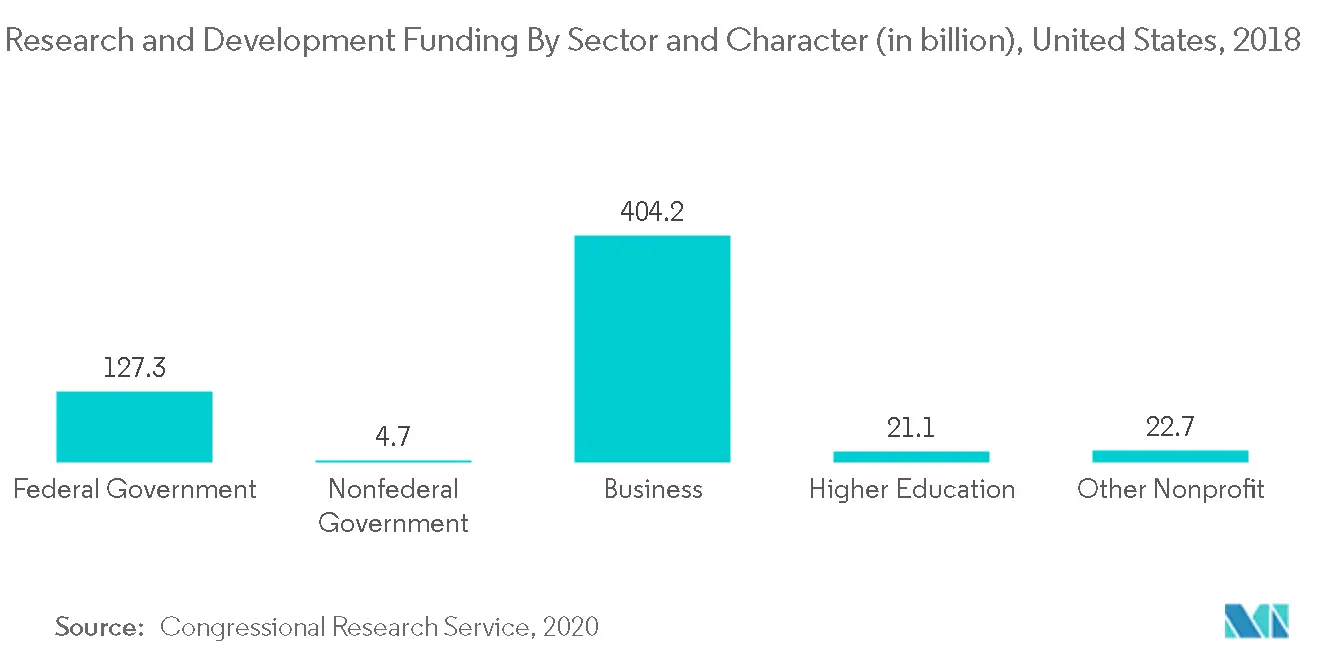
North America is Expected to Dominate the Microscopy Device Market Over the Forecast Period
North America holds a major share in the microscopy device market and is expected to show a similar trend over the forecast period mainly due to the huge investment in the research and development activities and in North America, the United States will hold the largest market in the microscopy device market in the region.
The major factors contributing to the market growth in the United States are the growing burden of chronic diseases, technological advancements in the field of microscopy, growing product launches, rising adoption of key strategies such as partnerships and acquisitions, and growing investments expected to lead to market growth.
According to the American Cancer Society, Inc. in 2022, an estimated 1.9 million new cancer cases will be diagnosed and an estimated 609,360 cancer deaths in the country. About 236,740 new cases of lung cancer will be diagnosed in the country in 2022. The same source also states that 79,000 new cases of kidney cancer and 13,920 deaths are estimated in 2022 from Kidney cancer. The high burden of cancer is expected to boost the life science research for developing new therapies for treating cancer, thereby augmenting the demand for microscopes and thus, driving the market.
In June 2022, ZEISS Microscopy entered into a strategic partnership with LabCentral to provide access to key life science microscopy innovations for imaging and analysis solutions to researchers in LabCentral in the United States for routine cell culture assessment, automated high-resolution imaging of live cells and whole slide scanning of fixed cells and tissues. Such partnerships will provide the accessibility of advanced microscopes in the country, which is expected to drive the market in the future.
In July 2021, Thermo Fisher Scientific launched Phenom Pharos G2 Desktop Field Emission Gun - Scanning Electron Microscope (FEG-SEM) designed to increase the access to advanced nanomaterial research capabilities.
In March 2021, EUROIMMUN, a PerkinElmer, Inc. company launched EUROPatternTM Microscope Live (EPML) compact immunofluorescence microscope, bundled with EUROLabOfficeTM 4.0 (ELO 4.0) laboratory management software. The combined system of hardware and software allows for ultrafast automated immunofluorescence image acquisition, pattern recognition, and titer estimation as well as modern diagnostics at the screen. Thus, the launch of technologically advanced products in the field of microscopy will also augment the market.
In June 2021, the University of Maryland (UMD) received USD 10 million in research investment for 7 projects by the UMD Research Instrumentation Fund. One of the key projects named "Light Sheet Instrument for Multiscale Cell Dynamics" included a dual-inverted selective plane illumination microscope. Hence, such investments are expected to increase market growth in the upcoming future.
Thus, due to the above-mentioned factors, the studied market is expected to grow in the United States during the study period.
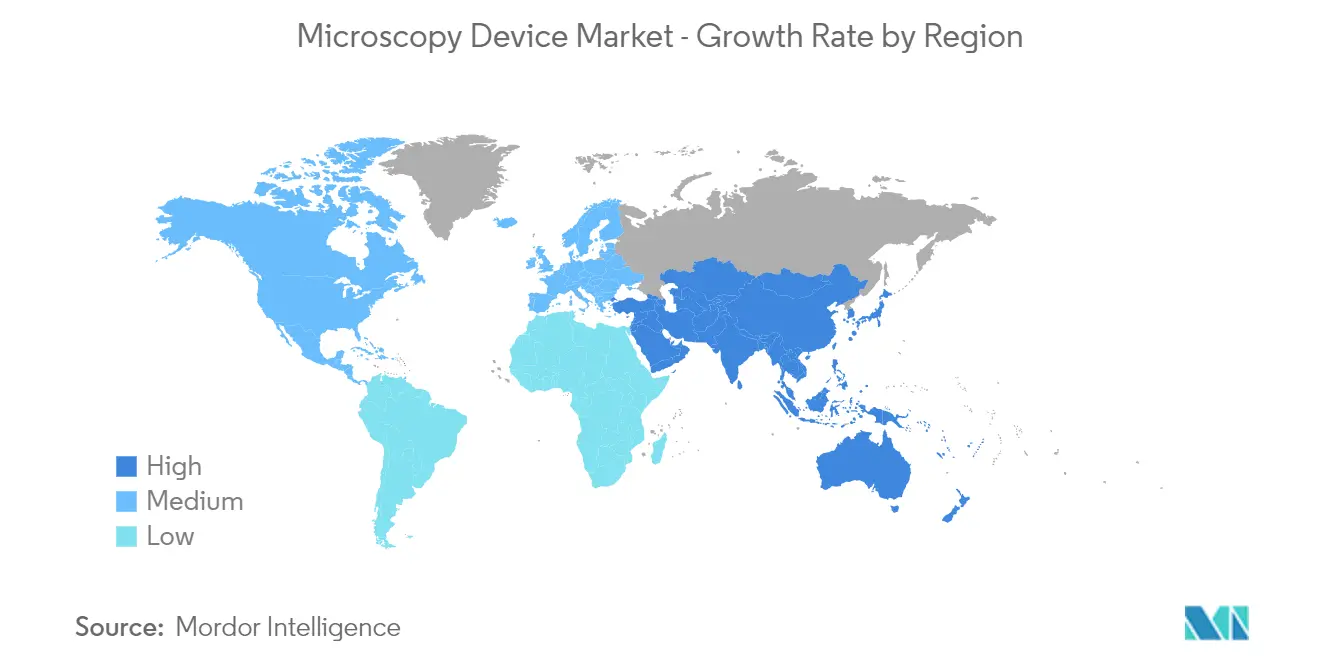
Microscopy Devices Industry Overview
With the rising focus on nanotechnology and the significance of microscopy devices in disease diagnosis and other applications, certain small to mid-sized companies are also venturing into the market with their advanced and innovative products. It is expected that such smaller companies will hold a substantial share of the market studied in the future. The Microscopy Devices market includes global players such as Bausch Health, Bruker Corporation, Carl Zeiss, Thermo Fisher Scientific, Olympus Corporation, and others.
Microscopy Devices Market Leaders
Bruker Corporation
Carl Zeiss
Thermo Fisher Scientific
Olympus Corporation
Danaher Corporation (Leica Microsystems GmBH)
*Disclaimer: Major Players sorted in no particular order
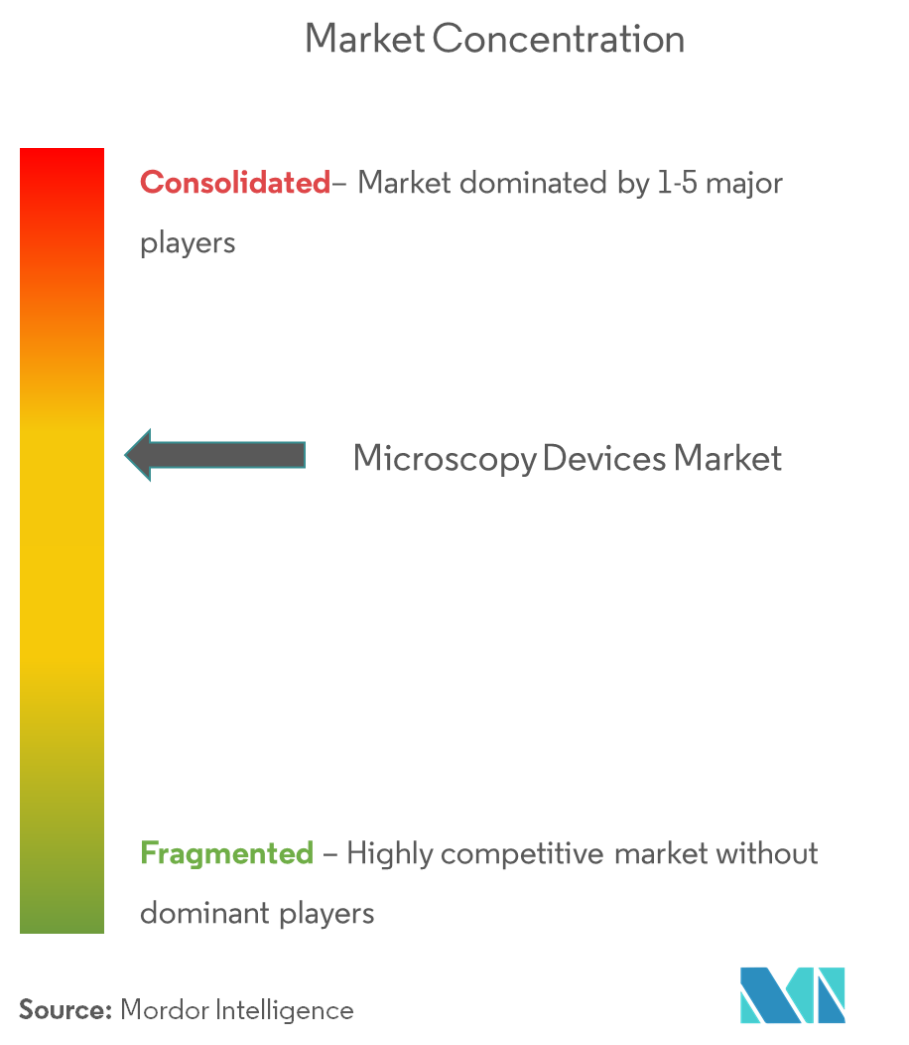
Microscopy Devices Market News
- In May 2022, Scientists at Columbia University in New York City developed a high-speed 3D microscope for the diagnosis of cancers and other diseases with real-time imaging within the living body.
- In April 2022, the state-of-the-art cryo-transmission electron microscope by ThermofisherScientific Inc. was inaugurated at the Centre for Cellular and Molecular Biology (CCMB). This microscope will help scientists to accelerate potential cures, drug discoveries and diagnostic research.
Microscopy Devices Market Report - Table of Contents
1. INTRODUCTION
1.1 Study Assumptions and Market Definition
1.2 Scope of the Study
2. RESEARCH METHODOLOGY
3. EXECUTIVE SUMMARY
4. MARKET DYNAMICS
4.1 Market Overview
4.2 Market Drivers
4.2.1 Technological Advancements in the Field of Microscopy
4.2.2 Increasing Demand for Focus on Nanotechnology and Life Science Research
4.3 Market Restraints
4.3.1 High Cost of Advanced Microscopy Devices
4.4 Porter's Five Force Analysis
4.4.1 Threat of New Entrants
4.4.2 Bargaining Power of Buyers/Consumers
4.4.3 Bargaining Power of Suppliers
4.4.4 Threat of Substitute Products
4.4.5 Intensity of Competitive Rivalry
5. MARKET SEGMENTATION (Market Size by Value - in USD Million)
5.1 By Type
5.1.1 Electron Microscopy
5.1.2 Optical Microscopy
5.1.3 Scanning Probe Microscopy
5.1.4 Others
5.2 By Application
5.2.1 Nanotechnology
5.2.2 Life Science
5.2.3 Semiconductor
5.2.4 Material Science
5.2.5 Others
5.3 By End User
5.3.1 Hospitals, Clinics and Diagnostic Laboratories
5.3.2 Academic and Research Organizations
5.3.3 Others
5.4 Geography
5.4.1 North America
5.4.1.1 United States
5.4.1.2 Canada
5.4.1.3 Mexico
5.4.2 Europe
5.4.2.1 Germany
5.4.2.2 United Kingdom
5.4.2.3 France
5.4.2.4 Italy
5.4.2.5 Spain
5.4.2.6 Rest of Europe
5.4.3 Asia-Pacific
5.4.3.1 China
5.4.3.2 Japan
5.4.3.3 India
5.4.3.4 Australia
5.4.3.5 South Korea
5.4.3.6 Rest of Asia-Pacific
5.4.4 Middle East and Africa
5.4.4.1 GCC
5.4.4.2 South Africa
5.4.4.3 Rest of Middle East and Africa
5.4.5 South America
5.4.5.1 Brazil
5.4.5.2 Argentina
5.4.5.3 Rest of South America
6. COMPETITIVE LANDSCAPE
6.1 Company Profiles
6.1.1 Hitachi High-Tech Corporation
6.1.2 Bruker Corporation
6.1.3 Carl Zeiss
6.1.4 Thermofisher Scientific (FEI Company)
6.1.5 JEOL Company
6.1.6 Danaher Corporation (Leica Microsystems GmbH)
6.1.7 Nikon Corporation
6.1.8 Olympus Corporation
6.1.9 Park Systems
6.1.10 Tescan Orsay Holding AS
6.1.11 Labomed, Inc.
- *List Not Exhaustive
7. MARKET OPPORTUNITIES AND FUTURE TRENDS
Microscopy Devices Industry Segmentation
As per the scope of the report, the microscopy devices are one of the most important devices in any laboratory that are used in the structural analysis of any biological or non-biological object or material at the micro or nano level which cannot be performed through the naked eye. The microscopy devices are used widely across the life sciences domain as well as material science and information technology. The microscopy device market is segmented by type (electron microscopy, optical microscopy, scanning probe microscopy, and others), application (nanotechnology, life science, semiconductor, material science, and others), end-user (hospitals, clinics and diagnostics laboratories, academic and research organization, and others), and geography (North America, Europe, Asia-Pacific, Middle East and Africa, and South America). The market report also covers the estimated market sizes and trends for 17 countries across major regions globally. The report offers the value (in USD million) for the above segments.
| By Type | |
| Electron Microscopy | |
| Optical Microscopy | |
| Scanning Probe Microscopy | |
| Others |
| By Application | |
| Nanotechnology | |
| Life Science | |
| Semiconductor | |
| Material Science | |
| Others |
| By End User | |
| Hospitals, Clinics and Diagnostic Laboratories | |
| Academic and Research Organizations | |
| Others |
| Geography | ||||||||
| ||||||||
| ||||||||
| ||||||||
| ||||||||
|
Microscopy Devices Market Research FAQs
How big is the Global Microscopy Device Market?
The Global Microscopy Device Market size is expected to reach USD 9.67 billion in 2024 and grow at a CAGR of 5.82% to reach USD 12.84 billion by 2029.
What is the current Global Microscopy Device Market size?
In 2024, the Global Microscopy Device Market size is expected to reach USD 9.67 billion.
Who are the key players in Global Microscopy Device Market?
Bruker Corporation, Carl Zeiss, Thermo Fisher Scientific, Olympus Corporation and Danaher Corporation (Leica Microsystems GmBH) are the major companies operating in the Global Microscopy Device Market.
Which is the fastest growing region in Global Microscopy Device Market?
Asia-Pacific is estimated to grow at the highest CAGR over the forecast period (2024-2029).
Which region has the biggest share in Global Microscopy Device Market?
In 2024, the North America accounts for the largest market share in Global Microscopy Device Market.
What years does this Global Microscopy Device Market cover, and what was the market size in 2023?
In 2023, the Global Microscopy Device Market size was estimated at USD 9.14 billion. The report covers the Global Microscopy Device Market historical market size for years: 2019, 2020, 2021, 2022 and 2023. The report also forecasts the Global Microscopy Device Market size for years: 2024, 2025, 2026, 2027, 2028 and 2029.
Microscopy Devices Industry Report
Statistics for the 2024 Microscopy Devices market share, size and revenue growth rate, created by Mordor Intelligence™ Industry Reports. Microscopy Devices analysis includes a market forecast outlook to 2029 and historical overview. Get a sample of this industry analysis as a free report PDF download.
